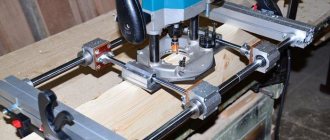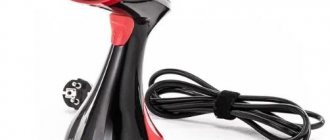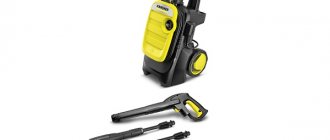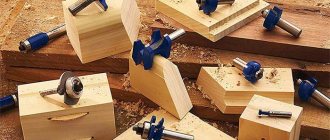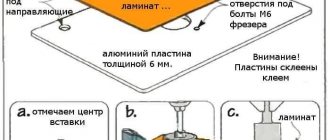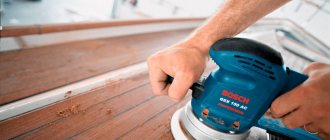Why do you need a router?
A wood milling machine is a tool that allows you to make cuts, grooves, cut out joints, and also remove a thin layer of material. This tool is used in carpentry, when constructing furniture and when working with parquet or laminate. With its help, you can make longitudinal edges, complex patterns, tenon joints, and also cut grooves for dowels and dowels.
Why you need a router can be understood if you understand its varieties and structure, as this will help you choose the necessary tool.
Circular groove Source m-stone.ru
Types of hand routers
Hand-held devices come in 5 varieties. Each type has its own design features that affect the scope of application.
Manual type of equipment
The most common types of hand routers:
- Submersible. This is a universal device, characterized by high reliability and quality workmanship. This type of equipment is used to perform all types of milling work.
- Edging. Used for chamfering, as well as forming small recesses and depths. Used for decorative works. Such a tool is not used for domestic purposes.
- Rotary is used in construction work. The tool is used to process edges and make holes in plastic, wood or drywall.
- Lamellar is a specialized router designed for making grooves. This is not a universal tool, and therefore should not be purchased by beginners.
- The filler is another specialized device with which you can carefully make paired holes, which will subsequently be connected to each other. This tool is also not used in everyday life, and in most cases is used to make various furniture.
The choice depends specifically on the specifics of the master’s work. If you need to use equipment at home, then first of all pay attention to a universal tool.
Important! Certain samples are quite universal, while others are professional tools that can only be used to perform a narrow range of work.
Types of router
To choose which hand router is suitable for a given purpose or intended for universal use, you should familiarize yourself with the manufacturing options of this tool and what each of them is used for.
Types of attachments Source perego-shop.ru
Rod
The submersible model has a body that is mounted on a special rod, along which it can move vertically. A support mechanism is attached to the bottom of the guide. The entire unit is placed on it and, using the side handles that need to be pressed, it is immersed in the material.
After finishing the work, release the handles and the router will rise up under the pressure of the springs. It can be used to make grooves, cutouts, holes or joints, as well as curly patterns. Due to its high functionality, this model is considered universal, but the increased weight does not allow it to work well in vertical areas. Working with a router for beginners with this tool will be simpler and more understandable.
Tool with immersion mechanism Source i.allo.ua
Edging
An edge tool (trimmer) is capable of working not only on horizontal surfaces, but also on vertical ones. Most often it is small in size, so it can be used with one hand. The body itself has a narrowing and a special rubberized coating. This is necessary to use it as a handle.
The bottom of the device has a sliding surface to prevent scratches and also for smoother movement. The immersion depth of the cutter is changed using a special scale. With this tool you can use additional attachments: a rip fence - for processing the edges of a part or corners, as well as a copying sleeve, which allows you to make cuts according to a template.
Using this tool, you can process laminated or veneered parts, select grooves, round corners, fit blanks, and make shallow cutouts for decoration. The trimmer is recommended for use in workshops that require daily edging work.
Edging router Source www.rucne-naradie.sk
Lamellar
The body of such a tool has a horizontal body and is similar in design to a grinder. At the bottom it has a mechanism for operation, and a wide handle is attached above it. This model is equipped with a disk cutter for cutting into wood. To work, you need to press the tool on the material to immerse the cutter inside. Thus, you can make a special groove for attaching oval parts (lamellas).
It is recommended to work with a manual router of this type for making grooves or trimming parts. This machine is not suitable for rare use, since its purchase will not pay for itself. Therefore, you should choose such a model for frequent use in workshops for which it is needed every day.
Lamellar router Source laukar.com
Additive
This type of milling tool is similar in shape and design to a lamellar one, but there is a significant difference in its mechanism. To operate, this model uses 2 spiral cutters that work on the principle of a drill. With their help, an accurate connection of parts is made, since they cut into the material at a certain distance from each other. When immersed, the tips cut grooves into which dowels can be installed.
This type of tool is used in furniture production to connect parts whose fastening areas need to be made invisible. The cutter for this tool can be dowel or dowel. With their help, you can make holes for detachable and non-demountable connections.
Filler milling machine Source harrer.at
Rotary
This type of tool is similar in operating principle to a rod tool, but has a smaller size and a narrowed body, like an edging tool. It can be used for woodworking or ceramic tile work. It is also capable of processing plasterboard floors, chipboard, plastic and soft types of metal. Its speed reaches 30 thousand per minute, which makes it possible to work with hard materials.
The small size of the device makes it possible to work with a manual wood router using one hand, since its weight is small. When replacing a cutter, you can install a diamond rod or a cutter for working with ceramics. Using this type of tool, if it is equipped with speed control, work is performed on materials of varying densities, for example, cutting holes or processing edges.
Rotary router Source allegroimg.com
Recommendations for selection
In addition to visual appeal, the selected router must meet the wishes of the consumer on a technical level. When you pick up the tool, you need to check:
- Rod mechanism . The body should move along the guides smoothly, without jamming or excessive force. The accuracy of adjustment of the immersion value corresponds to the declared parameters.
- Ergonomics . When testing the rod mechanism, the convenience of the handles is simultaneously checked. There are two options - mushroom or pistol.
- Working test. Checking operation at idle - metallic noises, rattling, increased vibration indicate poor assembly.
- Power . Determined by the type of work. High performance will allow you to perform deep passes, but the weight, dimensions, and price increase. The golden mean is plus 10~20% of power to the required values. This will reduce peak processing conditions and extend the service life of the tool.
- Adjusting the rotation speed . The main indicator is the elimination of the possibility of changing the configured parameters. Hence, the switch operates in steps and is located in an “inconvenient” place, which does not allow it to be accidentally acted upon.
- Matching cutting equipment. The geometric parameters of the cutters and the dimensions of the shank must correspond to the hole in the sole and the collet clamp.
- Immersion depth. The ideal is that the collet extends beyond the bottom edge of the platform. Good - it reaches the bottom of the sole.
- Price. A high-quality milling cutter with optimal technical capabilities cannot have the price of a counterfeit product.
Main characteristics
Working with a milling cutter largely depends on the characteristics of the tool. The weight of the device is directly related to its power, since the more power there is, the heavier and larger the motor inside the case. The maximum size and length of the cutter also depends on the engine power. It also gives rise to the classification of tools by size:
- a device weighing 2-3 kg and a motor of 420 - 750 W is considered light;
- a medium-sized milling cutter has a power from 800 to 1450 W and a weight of up to 5 kg;
- a tool is considered heavy if it has a 1500-2300 W motor installed and its weight starts from 6 kg.
Professionals give advice for dummies on how to choose a manual wood router for the home, after analyzing the volume and complexity of the work. Beginners should opt for a lightweight instrument, as it is easier to learn.
Small device Source cdnmedia.220-volt.ru
Its heating speed also depends on the power of the device: the weaker the engine, the faster it heats up. Therefore, to make deep cuts or frequent milling, you should use a tool that has a motor of 1500 W or more installed.
If there is a choice of models whose power differs by no more than 200 W, then you should choose the one with the maximum power, since it will be able to work under the same loads and not overheat.
One of the important parameters for working with a milling cutter on wood or hard material is the number of revolutions it makes in 1 minute. (rpm). Most often, the device has a function for changing the speed, since in its absence it will become less universal and will not be suitable for all materials.
To operate, the milling cutter can use speeds from 3 to 35 thousand rpm. Also, the number of rotations depends on the diameter of the cutter. When working with thick cutters, you should reduce the speed to prevent the material from burning. It is necessary to work with hard rocks at low speeds, since the high density of the material may cause the tool to break.
Option for working with tiles Source domagazine.ru
The working stroke of a cutter is the depth to which the cutter can be immersed. For small models, the maximum value of this parameter reaches from 30 to 50 mm, and for large ones – 80 mm. The higher this value, the larger and heavier the device will be.
It is impossible to cut a deep groove on the first pass, so tools of different sizes are required. First, a 3 mm groove is made with a light tool. Next, the groove is deepened using a medium-sized bottom milling cutter to a depth of up to 6 mm, after which a heavy unit is used to increase the groove to 8 mm or more.
It is impossible to make a groove whose depth is greater than the working stroke, but it is possible to make a groove less. To do this, you need to change the inclination of the vertical stop using a special regulator, which is installed in the upper part of the tool. With it you can adjust the depth with an accuracy of 0.1 mm.
Adjusting the working stroke works the same for all types of cutters. Using a special stop, the immersion stops the moment the cutter reaches the desired depth.
Types of manual milling machines
Initially, hand routers were used exclusively for working with wood. Today you can find simply a huge number of versions of this tool, for example, some are used for processing natural or artificial stone, others - metals and plastics. A universal router is used to perform various carpentry works that involve the production of furniture or decorative items of complex shape. It can be used for the following operations:
- Formation of grooves, tenons, folds and other recesses in material with a certain shape. The plunge router is very common, as it is suitable for performing a wide variety of technological tasks.
- Quarter sampling is also carried out quite often in the manufacture of various wood products.
- Very often, carpentry work involves creating seats for locks or various fittings. It is almost impossible to make a suitable hole or recess efficiently without a suitable wood router.
- Profiling an edge along a straight or curved path. You can find an edge router on sale that is ideal for the task at hand.
- Drilling holes. Milling machines are used extremely rarely to make holes in wood, since a drilling machine is best suited for this. However, if the hole has an offset axis or an unusual shape, then the wood router in question is more suitable than others.
- Adjustment of connected parts. When performing carpentry work, quite often it is necessary to connect individual elements. In order for them to fit perfectly against each other, precise processing of the end surfaces must be carried out.
- Aligning the contour during roughing. An electric milling cutter can be used for rough surface treatment and obtaining a given shape. This tool is designed to remove large amounts of material.
- Creation of decorative carvings. In some cases, surface finishing involves the creation of decorative carvings, which are intended only for decoration.
Types of cutters for a hand router
Types of cutters for a hand router
When considering the types of milling cutters, it is worth considering that they are classified primarily by purpose or scope of application. Some are characterized by versatility, others are suitable only for complex and unusual operations. The classification is as follows:
- Submersible or vertical is a type of tool that is used to produce various holes and grooves, as well as chamfering and milling a closed contour. This version has become widespread and is used both in the home workshop and in industrial workshops.
- An edge trimmer or trimmer is a design option that is designed for making a groove, chamfering, and cutting shallow recesses of complex shapes. This wood router is characterized by the fact that it can be used to work with materials covered with veneer or laminate. Experts note that it is advisable to purchase this version only for everyday use.
- Rotary – A tool used to make holes in wood, ceramic or drywall. A distinctive feature is that this design option allows you to control the depth of the holes created with high accuracy.
- Lamellar is used exclusively for making grooves.
- The filler tool is extremely rare, as it is used to produce paired holes.
Electric milling machines are used to significantly speed up the processing process. However, in some cases it is practically impossible to do without a manual device. A modern electric motor can have a different speed, for which special regulators are installed.
Equipment and additional features
Using variable equipment, you can simplify and speed up wood milling work:
- A rip fence is a device that helps you rout areas that run in the same direction as the edge of a part. It is attached to the working edge of the tool using 2 rods and secured with screws. The accuracy with which you can adjust the position of the cutter and how high-quality the cut will be depends on how tightly this part is tightened. Depending on the model and manufacturer, the number of screws varies from 2 to 4.
- A cutter may have several cutting edges. An increase in the number of cutting surfaces affects the accuracy of the groove made, and a decrease affects the speed of its cutting. Most often, the kit comes with a cutter for 2 cutting edges, but these surfaces can be from 1 to 4. It is recommended to use a tool with 1 knife for rough work, and finish it with a cutter with 4 surfaces.
Types of incisors Source p0.zoon.ru
- The cleanliness of the processing and the cutting speed depend on the level of inclination of the knives on the cutter. There are straight and oblique cutting surfaces. The second option makes the holes more accurately and can be either left or right inclined. One produces more accurate chip removal, and the second produces high-quality cuts.
- The milling cutter sole is the part that will be in contact with the material. It must have increased strength to support the cutter's own weight and operator pressure. Most often they are made of cast or stamped metal, less often of plastic, since it is very fragile. The cast part is installed on expensive models, and the stamped part on cheaper ones. A smooth plastic cover is installed on top of it, which should prevent scratches and make the movement of the tool easier and smoother. If the nozzle breaks, it can be replaced with a similar one, or one made independently from scrap materials, for example, plywood.
- The miter gauge and compass can be used for rounding parts, finishing corners and cutting round parts of different sizes.
Compass for cutter Source 7routertables.com
- The guide bar is similar in properties and operating principle to the side stop, but it can be fixed independently of the edge of the workpiece. The length of removal from the material is adjusted using a special ruler, which is secured with clamps. An attachment is installed on the router itself, which moves along the cells in the ruler.
- The copy sleeve and ring are used together. The first part is needed for complex figured cutting according to a drawn template. During operation, the edge of the device rests against the border of the design, which is why the copy will come out slightly larger than the original template. The ring is needed to close the groove for the bushing if it is not needed.
- The guide rod is a mechanism for smoothly immersing the cutter into the material. It is installed on vertical type devices. With the help of springs installed inside it, the unit is lifted automatically and smoothly. Manufacturers often equip rods with a protective casing that prevents dust from entering the structure.
Who needs a home router?
Before going to the store, you need to determine the range of tasks to be completed. There is no point in purchasing a compact model if you need to process hardwood, but it is ideal for occasional household use.
A home router is necessary for people who often process various surfaces. When purchasing, you must take into account the availability of equipment that comes with the kit. It is advisable to purchase a universal set, which includes edge, base, profile and spiral elements.
Important! If a home craftsman will often use the device, then it is additionally necessary to purchase special copying sleeves and collets.
Video description
This video shows useful additional devices:
- Adjustment of the cutting depth should be installed on all models of the tool, since it is possible to use a wood router with high precision only with the help of this part. The regulator should have a scale with marks, and the more accurately you can adjust the depth, the better the cut will be. Most often these divisions are made in millimeters, but they can also be in inches. The most precise products can change the depth of immersion by 0.1 mm. For more convenient changes, it can be equipped with a special screw. This part is usually made in the form of a rod, with which the router rests on the part when the desired depth is reached.
Device with regulator Source i.pinimg.com
Operating principle of the equipment
The principle of operation largely depends on the type of tool chosen. A vertical wood router has become widespread, which can be considered a universal tool suitable for a wide variety of applications. The manual wood milling machine has the following features:
- The design is quite simple; the equipment is mounted on the electric motor shaft. The cutter performs mechanical processing of the surface due to the presence of a cutting edge.
- The tool under consideration is represented by a design in which rotation is transmitted directly from the motor shaft. In other words, there are no gears or belt drive. Due to this, milling is faster, since unwinding the tool requires little time.
- The milling cutter body can move along special guides relative to the workpiece. The support platform is rigidly fixed to the base. Due to this, the capabilities of a manual wood router are significantly increased.
Working with a manual wood router is simplified by installing a special stop that allows you to adjust the depth of cut of the cutter. When lowering the structure, the cutting tool smoothly cuts into the tree. The router can be moved horizontally on wood.
Working with a hand router on wood
The classic design consists of the following elements:
- A collet clamp used to clamp a cutting tool.
- Support platform designed for mounting a wood router.
- Step-type plunge depth limiter.
- A grip handle used to control a tool.
- Vertical stop.
- Regulator for indicating the number of revolutions.
- A handle that allows you to adjust the cutting depth with high precision.
- Housing with electric motor.
- A handle designed for parallel adjustment of the stop position.
- Parallel stop.
- Draw lever.
- A button responsible for turning the tool on and off.
- Guide rods.
Hand milling device
The production of the instrument in question is carried out by a variety of companies. The popularity of the brand largely determines the quality of the wood router and its service life.
Video description
This video shows the main characteristics when choosing a router:
- A system that allows the cutter to start moving smoothly rather than jerkily can help avoid overloading the device when starting work. It also helps to process parts more accurately and prolongs the life of the cutter.
- An electronic device for automatically adjusting speed during operation is capable of maintaining the desired speed if a harder section of material, for example a knot, appears in the path of the cutter. This mechanism stabilizes the operation of the cutter and improves the quality of processing.
- The temperature control module is a very important design element when choosing a router, as it is responsible for the safety of the device. When the mechanism overheats, it automatically turns off the current supply to the motor. Instead, to reduce the cost of the design, a color indicator can be installed, which will show how overheated the unit is.
- Before choosing a router for working in a confined space, you should check whether it has LED lighting for the area in which the work will take place. This is necessary to use the device in places with limited lighting.
Tool with LED backlight Source prosto-instrumenty.ru
- The power cord is a very important element of the router. Its length should be long enough to make it convenient to work at a distance from the outlet. It is necessary that it does not interfere with work and visibility. A wire braided with reinforced thread will be stronger and more durable.
- A mount for installing a nozzle, which makes it possible to connect a construction vacuum cleaner, will help clean the work surface from dust and debris during work. This will protect the device from unnecessary damage, as well as improve visibility and simplify operation.
There are various attachments for installation on the device, since using a router on wood or other material requires the help of special cutters, because each of them can make a cut of a different shape:
- A straight groove cutter is made in the form of a cylinder and is needed for rectangular grooves.
- The U-shaped bit is used for a rounded groove, which is made using a hand-held device.
- A V-shaped cutter can make a groove at different angles of inclination of its walls. To do this, several such nozzles of different sizes are used.
V-shaped cutter Source cdn.vseinstrumenti.ru
Useful videos
A short review of hand routers for beginners: How to quickly and easily make a groove for extensions and hinges, see: How to choose a high-quality router for a home workshop, see a detailed review: Woodworking - table top milling: Inlay - wood ornaments: A hand router is a must tool for the home handyman. He will help you independently assemble furniture elements, make repairs in the apartment, and arrange the interior . Anyone can use it, but to do this, you should first familiarize yourself with the features of the device and the nuances of its operation.
Choosing a wood router
Below is information on which manual wood router to choose for home use and their rating, which will help you get acquainted with the models:
- Bosch GMF 1600 CE
It has a high cost and comparable quality. This model has a 1.6 kW motor and a drive that can immerse the cutter by 75 mm. The speed controller allows you to change their number from 10 to 25 thousand rpm. The immersion fixation scale allows adjustment with an accuracy of 0.1 mm.
This device weighs 4.3 kg and has LED backlighting. You can connect a vacuum cleaner to it, and it also has a turret and is able to maintain a constant speed under load.
- Makita RP1800F
Weighs 6 kg and can immerse the cutter 70 mm. The engine power is 1.85 kW. The speed can be adjusted from 10 to 22 thousand rpm, and the power cable length is 4 m.
The disadvantage of the device is the presence of only one collet, which is supplied in the kit. This one can regulate constant speed and lock the spindle under load, and it also has a turret.
Model Makita RP1800F Source 24ima.ru
- Hitachi M12V2
It has a 2 kW motor with the ability to deepen the cutter by 65 mm. The set includes 12 and 8 mm collets.
The disadvantage of the device is the rough change in immersion depth. The length of its power cable is 3.8 m. This milling cutter has a function for maintaining a constant speed under load, a speed control from 8 to 20 thousand rpm, as well as a turret stop and spindle locking under pressure.
When choosing a router, you should pay attention to whether such a model has adjustment of speed and precise immersion depth. These parameters improve the versatility of the device and make it possible to make more regular grooves.
Model Hitachi M12V2 Source www.skypka1.com
Design features that must be considered when choosing a router
Sole
The support platform of the router, called the sole by users, is one of the most important structural elements of the tool, so special attention should be paid to its quality. The sole can be made of either cast or stamped metal. The cast platform, thanks to its clear geometry and good fit to the surface of the workpiece, guarantees high quality work. It is not surprising that it is considered a sign of a high-class instrument.
The stamped sole is cheaper to produce, so it is usually installed on inexpensive milling cutters for household use.
The lower plane of the platform, i.e. the sole itself, must be covered with a special overlay. This element is usually made of plastic. For most routers, the plastic pad is removable, which makes it easy to replace it with a new one when worn.
When choosing a router, you should pay attention not only to the quality of the sole, but also to the size of the hole in it - the opening. It limits the maximum permissible size of the equipment: you simply will not be able to install a large-diameter cutter on a unit with a small opening in the support platform.
Rod mechanism
The milling cutter head moves along two vertically located guide rods. The ease of use of the tool and work productivity largely depend on how easy and smooth its movement is. The presence of backlashes and distortions, as well as excessive resistance to movement of the unit in the vertical direction, is considered a serious drawback, since it makes it difficult to use the router.
The depth of immersion of the cutter into the material being processed is limited by a vertical stop. This metal rod rests against a special area on the platform, preventing the head of the instrument from falling lower. When setting the milling depth, you simply move the stop rod up or down. This can be done using a special screw.
In addition to this, advanced units also have an adjusting screw for fine-tuning the depth with a micrometer scale. The more accurate the adjustment and the wider its range, the more high-quality and functional the tool you hold in your hands.
A multi-stage turret stop will help you make several passes with a gradual increase in the processing depth up to the specified one. Essentially, this is a special platform on a platform with several steps of different heights, into which a vertical rod rests, limiting the depth of milling. Sometimes the turret stop is made in the form of several bolts screwed into the platform; in this case, the height of the steps can be adjusted by screwing or unscrewing the bolts.
Equipment fastening unit
The hand router equipment is secured to the spindle using a collet chuck. It is a special nut with a collet located inside, screwed onto the spindle and clamping the shank of the inserted cutter. Lightweight milling cutters are designed for cutters with a shank diameter of 6–8 mm; powerful ones, as a rule, are equipped with collets with a diameter of 10–12 mm. The latter is easily explained: the larger the cutter, the thicker its shank and, at the same time, the higher the requirements for the power characteristics of the tool.
The diameter of the cutter must match the diameter of the collet. However, it is still possible to install a cutter with a thinner shank into a seat with a larger diameter. To do this, you will have to use a replaceable collet (or, in extreme cases, a special adapter sleeve). Even if it is not included in the tool kit, it can always be purchased separately.
When “replacing” a cutter like this, you should carefully ensure that the recommended rotation speed for it coincides with the parameters of the tool, otherwise the thin shank may not withstand excessive load.
A high-quality collet reliably fixes the shank strictly along the axis of the spindle, which eliminates the occurrence of vibrations that negatively affect both the quality of material processing and the condition of the tool. Collet clamps with a large number of clamping blades are preferable, as they better center the cutter.
Briefly about the main thing
A milling cutter is a device for processing parts and making grooves in them. It can be used to make chamfers, locking joints and figured carvings.
The most universal device is considered to be a plunge router, while the most professional and highly specialized devices are the lamellar and filler milling machines. Rotary and edging routers are needed for working in confined spaces or for special jobs.
The choice of a router directly depends on its functionality and what additional functions it has.
Ratings 0
Types of cutters used
Each type of material being processed requires the use of an appropriate attachment. Externally, the cutter consists of two parts: the cutting edge (working part) and the shank. It is important to know that pliable soft woods are processed with attachments made from lightweight materials, while hard wood species require an appropriate hard cutter.
There is another classification of nozzles:
- profile - simple processing of wood products;
- cone-shaped - processing at an angle;
- rectangular - working with grooves;
- V-shaped to produce holes with a 45-degree slope;
- disk - you can create different grooves in width and depth;
- molding will help to round the edge;
- rebated for quarter milling;
- “swallow’s nest” – tenon joints;
- fillets to create details of the same name on the edges.
It is worth knowing: for a manual household router you should use bearingless attachments - this will help in processing tools in any convenient place.
What is a router
A milling cutter is a tool that is used to process wood blanks. There are two types of equipment:
- A stationary machine, where the cutting element is firmly fixed with a clamp, the operator, when performing work, moves the part itself around the working platform.
- A hand tool that moves along a fixed workpiece.
The stationary version is used mainly in production. Hand tools are more suitable for household use. If necessary, it can also be fixed using special devices. The result is a prototype of an industrial milling machine.
The functionality of the router is not limited to processing flat surfaces of wooden parts. It is used for cutting out technological recesses (locking elements such as tongue-and-groove, ridge, loops, etc.).
Unlike a plane, ax and other carpentry tools, a router performs a given operation quickly with excellent quality.
List of functions of manual milling equipment:
- drilling holes (speed and power allows you to make holes inside logs, which a drill cannot handle);
- profiling the edge in the form of a straight or figured path (used to design the edge of steps, table surfaces, etc.);
- quarter/groove notch;
- making grooves/grooves on parts that look like a cone or cylinder (legs of a table, chair, etc.);
- cutting grooves, folds, splines, with the help of which the joining of furniture elements is carried out;
- alignment of contours after cutting the workpiece with a jigsaw;
- performing rough grinding;
- decorative carving;
- cutting tenons/edges to fit the parts to be connected;
- drilling mounting holes for awnings, locks, corners and other types of fittings;
- production of door/window frames (the need arises when connecting perpendicularly located elements).
The milling cutter is easy to operate; even a young man can handle the job. The process becomes clear after becoming familiar with the structure of carpentry tools. When first examining the equipment, the body attracts attention. It is in it that the main components and parts are located.
The operation of the unit is provided by the engine. The element protruding from the body is the holder. Collets are installed into it - special adapters into which cutters are inserted and fixed. The platform moving on a wood surface is made of metal. There are buttons on the body to start and stop the motor. Some models are equipped with a lock button.
What types of milling cutters are there?
Different types of tools are available. They differ in purpose and scope. The type of structure depends on the functions performed.
Submersible (vertical or rod)
This type of router gets its name from the direction of the head, which moves up and down during operation. The cutting element seems to sink into the surface of the wood while passing along two guide rods.
The tool is used to perform standard milling tasks: grooves, grooves, grooves, holes, rounding ends, chamfering, forming an edge profile. Area of application - mainly in households and small production workshops.
Cordless edge router Makita DRT50Z
Edge (edging or trimmer)
A narrow-profile tool whose functions are limited to shaping edging on wooden workpieces. The equipment also makes recesses, grooves, grooves, and chamfers. The router works well on types of wood such as plywood, laminate, and veneer.
The unit is used in woodworking industries and furniture shops. It pays off with daily work in the company. Not suitable for private use due to high price and limited functionality.
Lamellar (additive)
The milling cutter is low-functional. The range of tasks performed includes the creation of paired holes intended for connection with edges and dowels. Scope of application: furniture workshops, construction.
Of the existing types, the plunge router is the most popular. The tool is suitable for both enterprising owners and professionals.
